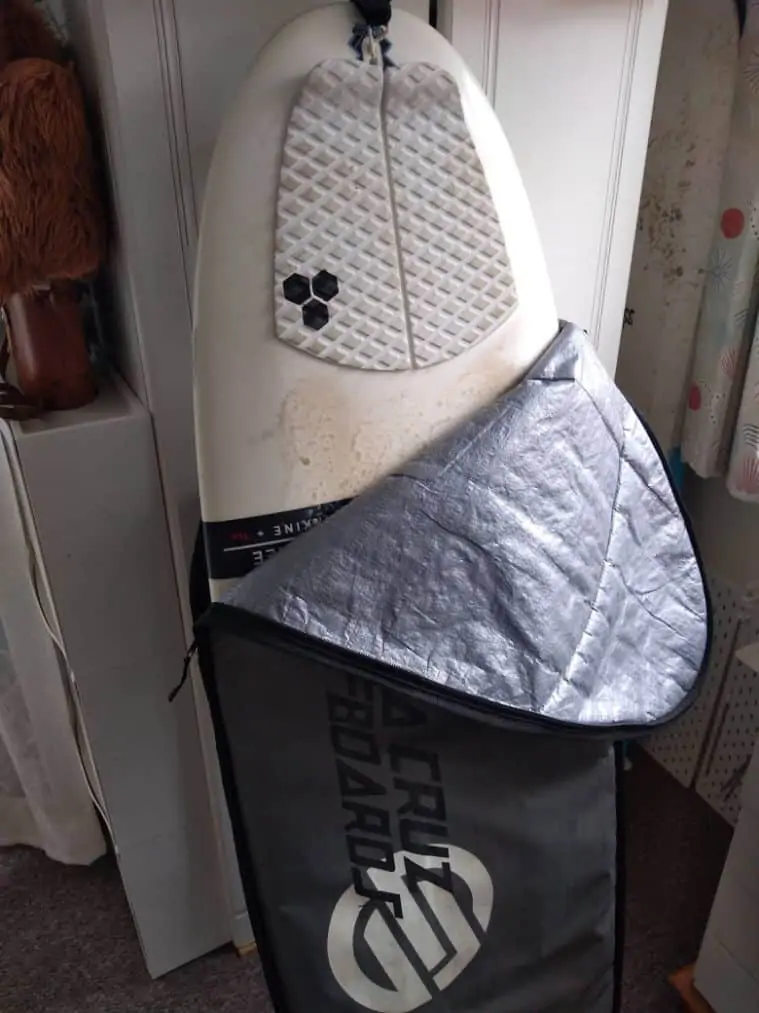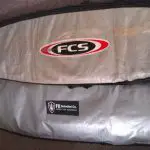How to Pack a Surfboard Bag
Traveling with a surfboard can be a major event and you will definitely need a good surfboard bag to do it. But when it comes to packing your surfboard bag, this can be a task all in itself.
So how do you pack a surfboard in a bag?
- Clean the wax off the boards
- Take the fins off
- Put the longest board on the bottom
- Throw in other soft items with them to pad them out
That’s the brief explanation, but now, let’s get into more detail on exactly how you can pack your surfboard bags for travel to minimize any risk of damage and to make sure your boards get there in one piece!

Get a Board Bag that is Six Inches to One Foot Longer than Your Surfboard
Using a board bag that is longer than your surfboard will mean that you can actually fit in more items around your surfboards while they’re packed in the bag.
You can then pad the bags out from the inside with other things like towels and any other soft items. You can also add in your wet suits or any other surfing accessories into the bag,
The extra length is helpful because as you fill the bag. It will allow for more items to be put inside it with the extra length taking up the slack. Saving on your baggage space for more items that are not directly surfing related.
So it’s a good idea to go a bit longer and it won’t look silly. It won’t affect the performance of the bag. It might sag a little bit at the end but if you fill it up, this won’t be noticeable at all, and it won’t have any negative impacts.
Get a Heavy Duty Board Bag, Not a Day Bag for Surf Travel
One of the worst things you can do is actually go cheaper on a board bag. A board bag that is thinner on foam and less padded, providing much less protection.
If you go on places like Amazon, the cheapest board bags are only for day use hence called day bags. The bags are designed to be lighter for convenience.
Although these are great for just going to the beach and shuttling your board back and forth in the car. They are not designed for the heavy wear of surfboard travel and airline travel.
However, going on an airline, you want to make sure your board is not going to get destroyed by clumsy baggage handlers or people in a rush. The added foam in a travel surfboard bag is much needed and it comes at a cost.
A day bag might have about 4 millimeters thickness of foam. Whereas a heavy duty travel bag is usually around 10 millimeters thick. It makes a huge impact on keeping your board secure and free from dings and cracks.
Remove Fins from All Your Surfboards to Go Into the Bag
Before putting any boards in the bag, you will need to take the fins off. The fins are a major weak point and will easily break if they are left on and pressure is applied to them.
Part of the reason for having to remove both fins is for ease of travel. You can fit more boards in your bags with fins removed and the fins are not a concern.
In the past, boards used to have glassed on fiber glass fins. If these crack or broke in transit, then you will need a ding repair to actually fix them to avoid breaking your board.
This is where FCS appeared and made a huge advance in surfboard travel. They have provided removable surf fins that are much more convenient.
To remove the fins from your board, simply get the right fin key and unscrew them, which should come with the fins or the board. This will take about five minutes, an easy and simple process often using a hex key.
If your hex key is rounding, go to a hardware store and buy a hex key made of harder metal. Surf fin companies sometimes supply cheap soft metal keys that only last a few uses.
After removing the fins, you can wrap them and put it in their bag to keep them together. Just make sure you put them in your surfboard bag so that you don’t forget them.
The worst thing would be to arrive and have forgotten to take your fins with you. Most travel surfboard bags will have pockets that you can put things in and is ideal for putting things like this in.
With fins, you might want to put them in the main bag compartment to avoid them putting pressure on the boards. So put them at the extreme end, the nose perhaps, in a loose space within the extra long bag.
Remove Wax if Taking More Than One Board or Traveling to a Different Climate
If you’re traveling to a surf destination with drastically different climate, you will need to remove your wax and reapply it. Surfboard wax melts in warmer water, depending on what temperature you have got the wax for.
Let’s say you’re going from Northern California to Hawaii. You would need to remove the wax anyway before you surf in Hawaii because you’ll need to reapply the tropical warm water wax.
Equally, if you don’t want the bottom of the board on top you put in to get dirty, if you’re taking more than one board, then you will need to remove the wax as well.
You can remove the wax with a wax scraper and a bit of a white spirit. You can also leave your board out in the sun for 10 to 15 minutes and it will melt very quickly. Simply scrape it off and finish with white spirit.
However, if you don’t have any sunlight, I would recommend just going for a bit of a scrape with the wax scraper, which are cheap to buy.
Don’t use a hairdryer because I would be concerned about de-laminating the board. Although you do see that recommendation elsewhere online.
If you’re traveling with only one board to a similar climate, then you may not even need to do this. It will just mean extra work that you don’t have to do. But you could do it if you want to keep things nice and clean.
Put Towels Around your Board or Between Multiple Boards in Your Bag
Towels are a great thing to pack into your surfboard bag. Not only do you need them but they also add a nice bit of padding. This is a good idea. That extra padding just helps to keep your boards a bit more protected inside.
You could add a surfboard sock. But I wouldn’t buy one specifically for this purpose as they’re only for preventing scratches.
Add Foam Pipe Insulation Along the Rails for Extra Protection
If you get some cheap foam pipe insulation from a hardware store and cut it to fit, you can line this up along the rails of your boards.
If you cut it in half, it should fit perfectly around the rails of your surfboards and give it much more protection.
Again, this is a cheap and easy thing you can do for added protection to your boards when they’re inside the board bag.
If you’ve gone for that extra length in your board bag, the width should also allow for a bit more padding to go in on the inside.
So making this a quick and easy win to help you protect your boards further. You could do this on the tail of your board as well. Although it might be a little bit difficult to do on the nose.
Add Bubble Wrap to the Nose of Your Board to Protect It
If you have any bubble wrap, wrap the nose of your board to stop the front tip or the point of it from cracking. Let’s say, if it gets hit, the board bag gets thrown into something in front of it then that could cause it to crack.
The bubble wrap will be very useful. It won’t stop it snapping if the baggage handlers put pressure on your board bag in the wrong place. But doing this is a nice extra bit of protection that you can take.
Put the smallest surfboard on the bottom if traveling with more than one. Start with the largest on the bottom with the nose upwards. You can then stack your boards on top and go from largest to smallest.
Each time, put the nose of the board on top, down a little bit so you should start with the tails all aligned on as you stack the boards within the board bag.








